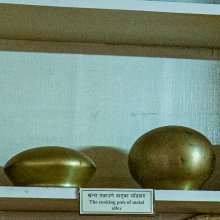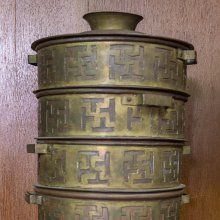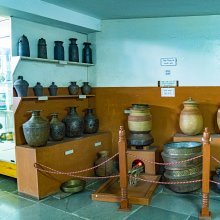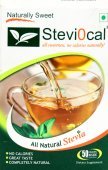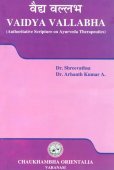Cooking: 1 definition
Introduction:
Cooking means something in Hinduism, Sanskrit. If you want to know the exact meaning, history, etymology or English translation of this term then check out the descriptions on this page. Add your comment or reference to a book if you want to contribute to this summary article.
Images (photo gallery)
In Hinduism
Purana and Itihasa (epic history)
Source: Shodhganga: Elements of Art and Architecture in the Trtiyakhanda of the VisnudharmottarapuranaCooking (of various leaves, soup, food etc.) is part of the “sixty four kinds of Art”, according to the Kamasutra of Vatsyayana.—Cf. the Sanskrit vicitraśākayūṣabhakṣyavikārakriyā.—Indian tradition, basically includes sixty four Art forms are acknowledged. The history of Indian Art covers approximately five thousand years which presents a rich and almost continuous record. The references of sixty four kinds of Kala (कला, kalā) are found in the Bhagavatapurana, Shaiva-Tantras, Kamasutra of Vatsyayana etc.

The Purana (पुराण, purāṇas) refers to Sanskrit literature preserving ancient India’s vast cultural history, including historical legends, religious ceremonies, various arts and sciences. The eighteen mahapuranas total over 400,000 shlokas (metrical couplets) and date to at least several centuries BCE.
See also (Relevant definitions)
Starts with: Cooking pot.
Query error!
Full-text (+743): Pacana, Paka, Randhana, Paca, Dridaka, Pacaka, Sthali, Pakti, Pakapatra, Paci, Svedanika, Vipaka, Pakima, Pakashala, Nipaka, Kharimpaca, Shrapana, Pacamana, Svayampaka, Antargriha.
Relevant text
Search found 228 books and stories containing Cooking, The cooking; (plurals include: Cookings, The cookings). You can also click to the full overview containing English textual excerpts. Below are direct links for the most relevant articles:
Manusmriti with the Commentary of Medhatithi (by Ganganatha Jha)
Verse 3.108 < [Section VII - Duties of the Householder]
Verse 5.7 < [Section II - Objectionable Food]
Verse 3.224 < [Section XIV - Method of Feeding]
Tattvasangraha [with commentary] (by Ganganatha Jha)
Verse 1148-1149 < [Chapter 16 - Examination of the Import of Words]
Verse 2085 < [Chapter 24a - The case for the reliability of the Veda (the Revealed Word)]
Verse 1157-1158 < [Chapter 16 - Examination of the Import of Words]
Vakyapadiya of Bhartrihari (by K. A. Subramania Iyer)
Verse 3.14.599 < [Book 3 - Pada-kāṇḍa (14): Vṛtti-samuddeśa (On Ccomplex Formation)]
Verse 3.7.91 < [Book 3 - Pada-kāṇḍa (7): Sādhana-samuddeśa (On the Means)]
Verse 2.376 < [Book 2 - Vākya-kāṇḍa]
Village Folk-tales of Ceylon (Sri Lanka), vol. 1-3 (by Henry Parker)
Story 54 - The Mouse Maiden < [Part II (b) - Stories of the Tom-tom Beaters]
Story 174 - The Parrot And The Crow < [Part III - Stories of the Cultivating Caste]
Story 119 - Nahakota’s Wedding Feast < [Part III - Stories of the Cultivating Caste]
World Journal of Pharmaceutical Research
Changes in polyphenolic compounds in taro during processing < [2021: Volume 10, September issue 11]
Cooking, a factor influencing heavy metal and herbicide concentrations in food < [2023: Volume 12, October issue 17]
Food processing techniques in bhavprakash nighantu and their current relevance < [2023: Volume 12, October special issue 18]
Bhaktavijaya: Stories of Indian Saints (by Justin E. Abbott)
46.16: Dnyandeva appears to Eknath in a dream < [Chapter 46 - Shri Khandya the Brahman]
27.9: Stories of Bhaktas not imaginary < [Chapter 27 - Narsi Meheta]
56.10: Niloba and his daughter’s wedding < [Chapter 56 - Santoba Bowar: Miloba: Uddhava Chidghan]
Related products
